
The demand for EVs has skyrocketed in both metropolitan and semi-urban areas as a result of the PM E-Drive Scheme’s cost reductions, making them a more and more popular option for short-distance transport. With the help of affordable models, three-wheelers—which are frequently utilized in last-mile delivery and commercial services—are also undergoing a substantial electric conversion, writes Akash Gupta, Co-Founder and CEO, Zypp Electric

The PM E-Drive Scheme is a major step in the direction of the Indian government’s ever-stronger commitment to creating an environmentally friendly and sustainable transportation network. This program focuses on electrifying two- and three-wheelers, which make up the majority of vehicle usage in India, to accelerate the adoption of electric vehicles (EVs). This program is anticipated to be crucial in achieving India’s lofty targets for energy efficiency and carbon reduction as the nation’s EV ecosystem develops.
Overview
Following previous incentives such as the FAME II (Faster Adoption and Manufacturing of Hybrid and Electric Vehicles) initiative, the PM E-Drive Scheme was introduced. This new program offers incentives designed especially for electric two- and three-wheelers, making them more affordable for users in both urban and rural areas. This program offers a significant incentive for manufacturers and customers to adopt e-mobility, as the government aims for 80 percent of two- and three-wheeler sales to be EVs by 2030.
The Booming EV Two- and Three-Wheeler Market in India
India’s market for two- and three-wheelers, which accounts for a sizable amount of the nation’s vehicle demand, has experienced impressive development in the electric vehicle market. About 944,000 electric two-wheelers were sold in FY2024, a 29 percent increase over the year before. Similarly, sales of three-wheeler EVs increased by 57 percent year over year to 632,000 units. These two groups together accounted for 94 percent of the Indian EV market, highlighting the PM E-Drive Scheme’s extensive reach and influence in these markets.
Growing customer acceptance of electric two-wheelers is shown in their popularity, which is driven by these models’ affordability and usefulness. Demand for EVs has skyrocketed in both metropolitan and semi-urban areas as a result of the PM E-Drive Scheme’s cost reductions, making them a more and more popular option for short-distance transport. With the help of affordable models, three-wheelers—which are frequently utilized in last-mile delivery and commercial services—are also undergoing a substantial electric conversion.
Impact on Sustainable Urban Transportation
The PM E-Drive Scheme directly addresses one of India’s most urgent environmental issues, as the nation is home to more than 20 of the most polluted cities in the world. Switching to electric vehicles (EVs) has the potential to drastically reduce emissions from two- and three-wheelers, which are major drivers of urban air pollution, particularly in densely populated urban centers. The program creates a positive feedback loop for sustainable urban transportation by lowering upfront costs for users and incentivizing manufacturers to invest in cleaner, more efficient technologies.
Challenges and Opportunities for Growth
Even though the PM E-Drive Scheme has attracted a lot of attention, there are still some issues. Mass adoption is still hampered by infrastructure constraints, particularly the dearth of charging stations in rural and semi-urban areas. Additionally, manufacturers face supply chain challenges due to the increased upfront demand in FY2024, which was partially prompted by announcements of subsidies.
These difficulties do, however, offer special chances for additional EV infrastructure investment, since several private companies are growing their EV charging networks throughout India. This expansion supports the long-term success of EV adoption in the nation by advancing the government’s goal of creating a more robust and extensive charging infrastructure.
Conclusion: Shaping the Future of India’s EV Ecosystem
By lowering the cost and increasing accessibility of EVs, the PM E-Drive Scheme is a driving force behind the transformation of India’s transportation system. India is on track to become a leader in e-mobility thanks to robust government support and an industry that can satisfy demand. India is positioned as a key player in the global EV ecosystem as the program propels growth in the two- and three-wheeler markets and accelerates the country’s transition to a cleaner, more sustainable future.
Resolving infrastructure deficiencies, maintaining consumer incentives, and encouraging investment in regional EV manufacturing are all critical to the initiative’s ongoing success. Together, these initiatives are laying a strong foundation for India’s electric vehicle ecosystem and laying the groundwork for a clean and energy-efficient future.